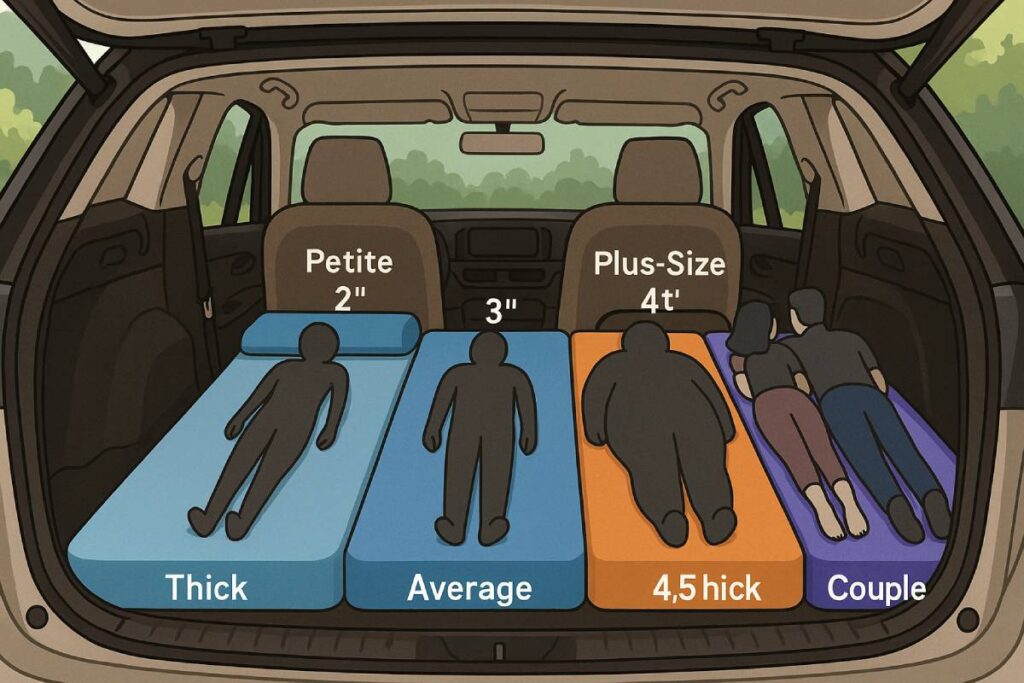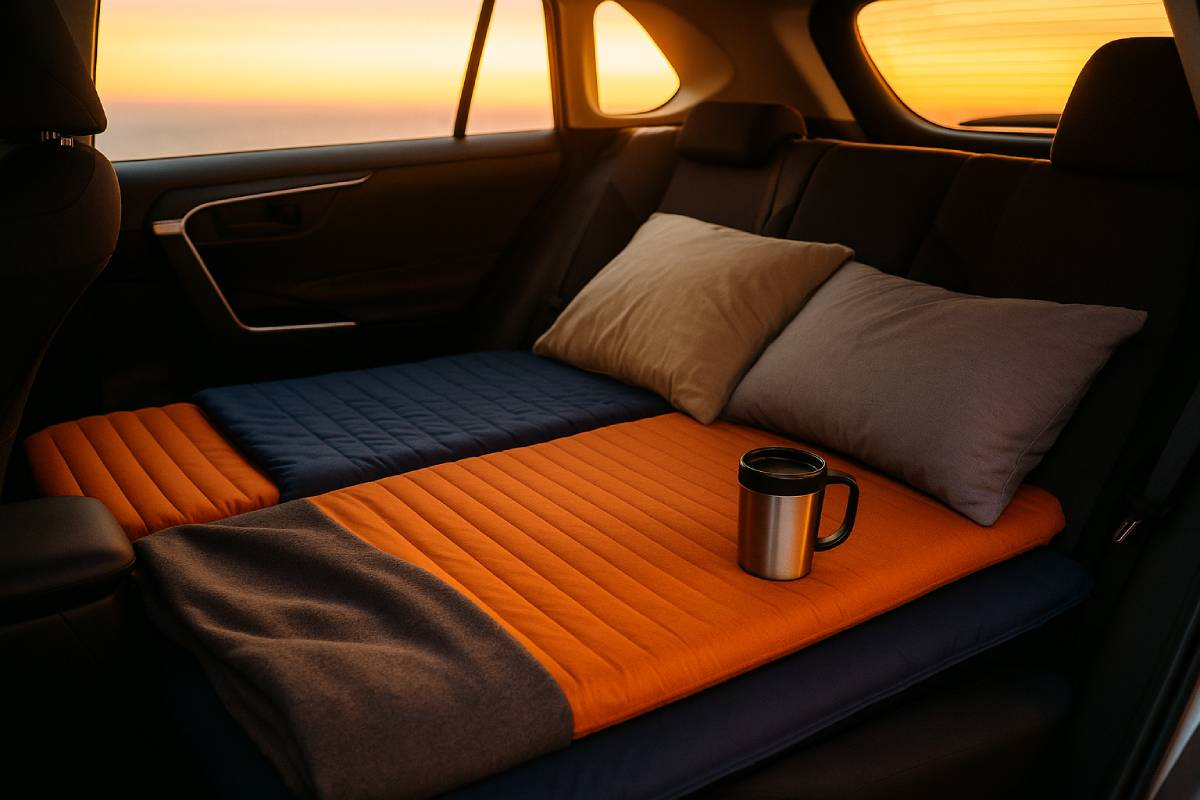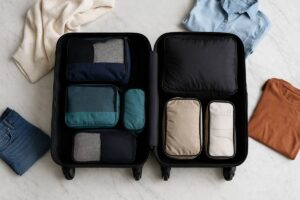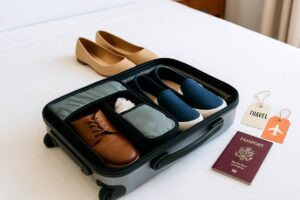Ready to turn your backseat into a blissful bed on wheels? Proper car-camp sleep gear isn’t a luxury—it’s a safety investment.
As Outside Magazine advises, “If you’re going to splurge on one product, splurge on your mattress”.
Whether you’re budget-minded or chasing five-star comfort, this guide helps you pick the right pad, platform, and accessories that fit your body, vehicle, and climate.
From under-$50 yoga mats that double as seat levelers to $200 self-inflating, high-R-value pads, we’ll cover setup tips, real user ratings, and maintenance hacks—so you wake recharged and ready for the next mile.
Budget-Friendly Sleep Solutions
Car camping doesn’t have to mean sacrificing comfort or draining your wallet—sub-$50 gear can transform your backseat into a cozy nest while keeping portability top of mind. Whether you’re chasing the perfect Train Travel Sleep experience or carving out car-camping bliss, the ISTROPIC 5 mm foldable yoga mat compresses to just 14.6 × 11.8 × 2 inches and weighs a mere 1.54 lbs, doubling as a cushioned pad that tucks neatly into a carry bag for $16.52

Beginner travelers rave about the Gaiam Premium 5 mm non-slip mat at $24.99, praising its durability, generous 68 × 24 in surface, and easy roll-up strap. For those braving cooler nights, the SWTMERRY rectangular sleeping bag delivers around 3 lbs of warmth in a weather-resistant nylon shell, packing down small in its compression sack for under $50.
And when you need a near-flat floor, simple blanket or pillow leveling hacks can balance uneven seats using items you already own, at zero extra cost, or with a spare blanket for under $20.
Reddit campers confirm that a $20 Gaiam Evolve mat from Walmart holds up for short car-camping trips, striking a solid middle ground between price and support. Meanwhile, outdoor sites note that yoga mats aren’t just for studios: their closed-cell foam repels moisture and insulates against chilly car upholstery.
Together, these wallet-friendly picks prove you can sleep smarter on the road without a luxury price tag.
Top Sub-$50 Sleep Gear Comparison
| Product | Price (USD) | Weight | Packed Size | Key Feature |
|---|---|---|---|---|
| ISTROPIC Foldable Yoga Mat | 16.52 | 1.54 lbs (0.7 kg) | 14.6 × 11.8 × 2 in | TPE foam, folds & straps into compact pouch |
| Gaiam Premium 5 mm Yoga Mat | 24.99 | ~2 lbs | 68 × 24 × 0.2 in | Non-slip surface, durable PVC, carrying strap |
| SWTMERRY Rectangular Sleeping Bag | 25–50 | 3 lbs | Compression sack | Weather-resistant nylon, roomier mummy cut |
| Gymenist Thick Exercise Yoga Mat | 5.79 | Lightweight | 24 × 71 in | Ultra-cheap, tear-resistant NBR foam |
| DIY Seat-Leveling Blankets/Pillows | 0–20 | — | Varies | Zero-cost hack to create flat recline |
These sub-$50 solutions blend minimal bulk with maximum comfort, making them perfect for budget-conscious road trippers, solo explorers, and families alike. By leveraging versatile yoga mats, compact bags, and simple hacks, you can achieve restful sleep in your vehicle without sacrificing trunk space or wallet real estate.
Mid-Range Inflatable Mattresses ($50 – $100)
Finding the right inflatable mattress for your car can transform those cramped back-seat naps into surprisingly comfortable slumbers. In the $50–$100 bracket, you’ll choose between manual-pump models—lightweight and ultra-compact but requiring a foot or 12 V inflator—and built-in pump designs that inflate in under two minutes at the touch of a button.
Comfort scores across these mid-range picks hover between 4.0 and 5.0 stars, reflecting robust materials like thickened flocked PVC and memory-foam cores. Plus, every built-in-pump mattress ships with its own carry bag, so you can fold it down to shoebox size and tuck it neatly in your trunk alongside your camping kit.
Manual-pump options such as the FBSPORT Inflatable Air Mattress (popular around $40 – $60) trim bulk and cost, but plan for an extra 5–10 minutes of pumping before bedtime. If you’re road-tripping nightly or hate wrestling with hoses, a built-in electric pump is worth the premium—and still keeps you under $100.
Built-in Pump Models Comparison
| Product | Price (USD) | Thickness | Comfort Rating | Setup Method | Amazon Link |
|---|---|---|---|---|---|
| DikaSun SUV Air Mattress | $67.99 (Prime) | 6.2″ | 4.2 / 5 stars | Built-in pump; carry bag included | View on Amazon |
| AKUDY Self-Inflating SUV Air Mattress | $83.49 | 6.7″ | User feedback: high | Built-in electric pump (2 min inflate) | View on Amazon |
| Umbrauto SUV Inflatable Air Mattress | $66.49 | — | 4.2 / 5 stars | Electric pump included | View on Amazon |
| KMZ SUV Air Mattress | $69.99 | 6.7″ | 5 / 5 stars | Rechargeable pump (90 sec inflate) | View on Amazon |
| Ciremiv Car Bed Inflatable Mattress | $59.99 | — | — | Built-in pump & accessories | View on Amazon |
Pro tip: If you’re covering hundreds of miles and want to minimize roadside fumbling, opt for a built-in pump model—two minutes to inflate beats five minutes of foot-pumping every night. For occasional naps or if trunk space is at a premium, manual-pump mats can save you 20–30 percent on cost and storage bulk—just pack a compact 12 V inflator or foot pump with your gear.
Premium Sleeping Pads ($100–$200): A Quick Look
For road trippers seeking a balance of warmth, comfort, and durability without breaking the bank, the $100–$200 premium segment delivers both self-inflating and insulated air pads that elevate car camping to near-mattress levels.
Self-inflating hybrids like the Nemo Flyer offer tool-free inflation, puncture-resistant foam cushioning, and rapid setup, while air-only insulated models such as the Nemo Tensor All-Season Ultralight and the REI Co-op Helix Insulated pack impressive R-values (3.3–5.4), thickness (2–3.5 in), and robust fabrics (20D–40D) for three-season comfort stored in compact stuff sacks.
OutdoorGearLab and REI experts consistently praise the Tensor’s warmth-to-weight ratio and the Flyer’s reliability, making these standout picks for travelers who demand easy setup, long-term durability, and true car-camp comfort.
Self-Inflating vs. Insulated Air Pads
- Self-Inflating (Hybrid) Pads
These combine open-cell foam and inflatable baffles for rapid, mitt-free setup and added puncture protection. Foam retention allows partial inflation with minimal air loss if punctured and cushions hard ground.- Nemo Flyer ($140): Offers a 3.3 R-value and 2 in of loft in a 6.5 × 10 in packed size, weighing just 1 lb 7 oz. Its 20-denier shell balances weight and toughness, though it requires caution on sharp debris.
- Insulated Air-Only Pads
These rely on air volume and synthetic insulation layers (e.g., Thermal Mirror™ film) for warmth and plushness. They pack down smaller but must be handled carefully to avoid punctures.- Nemo Tensor All-Season Ultralight ($200): Delivers a standout 5.4 R-value with 3.5 in loft, weighing as little as 14.1 oz and stowing in a 4 × 10 in sack. Premium 20D nylon on top and 40D nylon underneath offer exceptional tear and puncture resistance.
- Nemo Quasar 3D Insulated ($160–$200): Features a 3.3 R-value and 3.5 in thickness in a roomy rectangular shape, with 30-denier ripstop polyester for durability, weighing 1 lb 9 oz and packing to 8 × 4.5 in.
- REI Co-op Helix Insulated ($169): Balances a 4.9 R-value and 3 in loft at 1 lb 5 oz, incorporating improved baffle design and reflective insulation layers—an upgrade over earlier REI pads for better durability and heat retention.
R-Value, Thickness & Durability Comparison
| Model | Price | Type | R-Value | Thickness | Packed Size | Weight | Fabric Denier |
|---|---|---|---|---|---|---|---|
| Nemo Flyer | $140 | Self-Inflating/Air | 3.3 | 2 in | 6.5 × 10 in | 1 lb 7 oz | 20 D |
| Nemo Quasar 3D Insulated | $160–$200 | Air-Only Insulated | 3.3 | 3.5 in | 8 × 4.5 in | 1 lb 9 oz | 30 D |
| REI Co-op Helix Insulated | $169 | Air-Only Insulated | 4.9 | 3 in | 5 × 9.5 in | 1 lb 5 oz | Unavailable |
| Nemo Tensor All-Season Ultralight | $200–$230 | Air-Only Insulated | 5.4 | 3.5 in | 4 × 10 in | 14.1 oz | 20 D/40 D |
Table data courtesy SwitchbackTravel’s 2025 gear roundup
Long-Term Durability & Construction Insights
- Denier Matters: Higher denier ratings correlate with tougher, more puncture-resistant shells. The Tensor’s 20D/40D nylon and the Quasar’s 30D ripstop offer industry-leading abrasion resistance, while the Flyer’s 20D provides basic protection complemented by foam padding for accidental leaks.
- Repairability: All pads include repair kits; self-inflating models are easier to field-patch due to foam support, while high-loft insulated pads require careful seam and valve maintenance.
- Expert Feedback: OutdoorGearLab notes the Tensor achieves “best overall” status for warmth-to-weight, though some testers flagged durability concerns after extended use; the Quasar earns praise for its ultra-quiet fabric and softness.
Expert Picks & Road-Trip Recommendations
- Solo Travelers & Minimalists: The Nemo Flyer shines for its fast, tool-free inflation and compact pack size—ideal for quick overnights in cityscapes or beach pull-overs.
- Cold-Weather Comfort: For sub-freezing dip trips or high-elevation stops, the Nemo Tensor All-Season’s 5.4 R-value and robust construction are unmatched in this price band.
- Couples & Side-Sleepers: The rectangular Quasar 3D gives extra wiggle room and an elevated head baffle for pillow stability—perfect for back-seat setups or frontcamp lounging.
With these options, you can tailor your car-camp sleep system to your budget, setup speed, and seasonal needs—ensuring you wake refreshed and ready for the next leg of your adventure.
Car Camping Platforms and Setup
Car camping platforms like the Hele Box Solo and CarToCamp turn your everyday SUV or wagon into a cozy bunk with minimal effort. In my experience, both systems eliminate tent hassles and deliver a flat, supportive surface, with unique strengths in setup speed, tool requirements, and storage footprint. The Hele Box Solo assembles in under 5 minutes, needs no extra tools, and packs into a 34″ × 12″ × 8″ case that doubles as a storage bin.
CarToCamp’s flat-pack frame takes about 30 minutes on first build (and under 5 minutes thereafter), also tool-free, folding flat for easy trunk storage. For mattress pairing, the Hele Box Solo Pad (3″ hybrid foam/air) balances headroom and cushioning, while Redditors praise the Deepsleep Solo Mat (4″ custom foam) on the CarToCamp platform.
Hele Box Solo: Modular 3-in-1 Platform
Assembly Steps
- Unpack the case (which doubles as a compartmentalized storage container).
- Unfold the aerospace-grade aluminum frame and secure dual-lock legs to the desired height.
- Snap on wooden slats and dial in levelness using independently adjustable legs (in ½″ increments).
Required Tools
- None. All components click and lock into place; the set includes every fastener you need, no wrenches or screwdrivers required.
Collapse & Storage Footprint
- Packaged Dimensions: 34″ × 12″ × 8″, 25 lbs total system weight
- Storage Case: Doubles as a gear bin that slides neatly under the platform or stands alone as a compact storage tote
- Breakdown Time: Under 5 minutes—perfect for quick weekend getaways
Pairing with Mattresses
| Mattress | Specs | Why It Works |
|---|---|---|
| Hele Box Solo Pad | 72″ × 25″ × 3″; hybrid foam/air; anti-slip bottom | Low profile preserves headroom; no separate pad purchase needed |
| Exped MegaMat Auto | 77″ × 52″/41″ × 4″; R-value 8.1; self-inflating | Exceptional warmth & comfort; side cutouts fit wheel wells |
CarToCamp Sleeping Platform
Assembly Steps
- Remove platform pieces from the trunk.
- Lay out flat-pack frame sections and connect via integrated knobs.
- Adjust the front supports (64″–74″ length range) to compensate for seat-angle, ensuring a flat surface.
Required Tools
- None. Every joint uses hand-tightened knobs; no drills or tools ever required.
Collapse & Storage Footprint
- Folded Profile: Collapses flat to fit in most trunks; stows in original packaging or included storage bag.
- Initial Setup Time: ~ 30 minutes; subsequent breakdowns and rebuilds take under 5 minutes once you’ve learned the system.
Pairing with Mattresses
| Mattress | Specs | Why It Works |
|---|---|---|
| Beloit “Deepsleep” Solo Mat | 4″ custom foam cut to platform dimensions | Uniform support; seals edge-to-edge without gaps |
| Exped MegaMat Auto | 77″ × 52″/41″ × 4″; R-value 8.1 | Plush foam/air comfort ideal for longer stays |
Expert Tip for Both Platforms
Always test-fit your chosen mattress at home: size tolerances can vary by ± 1″, and a snug fit prevents shifting during the night.
By combining these tool-free platforms with the right pad—whether the integrated Hele Box Solo Pad or a proven custom foam solution like Deepsleep or Exped—you’ll enjoy stable, insulation-optimized sleep in your vehicle without bulky kits or complex installs.
Comfort Customization by Body Type

Tailoring your car-camp sleep system to your body type ensures restorative rest and reduces pressure points.
Petite sleepers (<130 lbs) can achieve comfort with 2–3 inch self-inflating hybrid pads that cushion without excess bulk.
Average adults (130–200 lbs) typically need 3–4 inch air or insulated pads offering medium-firm support and R-values around 3–4 for balanced cushioning and warmth.
Plus-size adventurers (>200 lbs) benefit most from 4–5 inch foam-plus-air pads such as the Exped MegaMat or REI Camp Dreamer, which combine high load-capacity with lasting durability.
For couples, dedicated double-wide pads (~4 in thick) or two independent singles let each partner dial in their firmness preference while minimizing nighttime drifting.
Petite Adults (<130 lbs)
- Thickness: 2–3 in (5–7.5 cm) is sufficient to keep light bodies insulated from cold surfaces without feeling “floating”.
- Firmness: Soft–medium density (closed-cell foam or hybrid pads) provides gentle contouring and reliable warmth; R-values from 1.4 to 3.4 work well.
- Example Pads:
- Therm-a-Rest Z Lite Sol (1.4 R, 0.9 in thick foam) for ultra-compact support
- Nemo Switchback (2 in, foam/air hybrid) for extra cushioning on hard seats
Average Adults (130–200 lbs)
- Thickness: 3–4 in (7.5–10 cm) balances support and pack size, preventing “bottoming out” under moderate loads.
- Firmness: Medium-firm air or insulated pads with R-values of 3.0–4.0 deliver consistent pressure distribution and thermal performance.
- Example Pads:
- Exped Megamat 10 (4 in, R-value 8.1) for plush comfort
- Big Agnes Divide 3D (3.5 in, R-value 4.0) for stable edge-to-edge support
Plus-Size Adults (>200 lbs)
- Thickness: 4–5 in (10–12.5 cm) ensures ample under-body clearance and prevents sagging under heavier weight.
- Firmness: Firm or high-load hybrid pads (foam core plus air chambers) maintain shape and resist punctures; aim for R-values above 3.5 for colder nights.
- Example Pads:
- Exped MegaMat Duo (4 in, R-value 8.1) rated for two adults or heavy individuals
- REI Camp Dreamer (4 in, foam/air hybrid) praised for durability and support
Couples
- Configuration Options:
- Double-Wide Pad (~4 in thick): Single surface, less drifting, unified insulation.
- Two Singles (3–4 in each): Allows individual firmness settings but may gap or shift.
- Firmness Sync: Choose medium-firm R-values (3.3–5.4) to suit mixed body weights and sleep positions.
- Example Pads:
- Exped MegaMat Duo for spacious, stable double sleep
- Therm-a-Rest NeoAir XTherm Twin (two 1.5 in pads zipped together) for tailored comfort
Quick Reference Table
| Body Type | Weight Range | Thickness | R-Value Range | Firmness | Pad Style |
|---|---|---|---|---|---|
| Petite Adults | <130 lbs (59 kg) | 2–3 in (5–7.5 cm) | 1.4–3.4 | Soft–Medium | Hybrid foam/air, closed-cell foam |
| Average Adults | 130–200 lbs (59–91 kg) | 3–4 in (7.5–10 cm) | 3.0–4.0 | Medium | Air pads, insulated self-inflators |
| Plus-Size Adults | >200 lbs (>91 kg) | 4–5 in (10–12.5 cm) | 3.5–5.4 | Firm | Foam + air hybrids (e.g., MegaMat) |
| Couples | Combined | ≥4 in (10 cm+) | 3.3–5.4 | Medium–Firm | Double-wide or two singles |
By aligning pad thickness, R-value, and firmness with your body type—and choosing the right single or double-wide configuration—you’ll wake refreshed and ready for the next mile of your adventure.
Vehicle Compatibility and Space Planning
Before you lay down in your ride, knowing your interior dimensions—especially length and width between wheel arches—is key to choosing the right sleeping setup.
By measuring length from the back of the front seats (pushed forward) to the closed hatch, and width between the wheel arches, you can match mattresses or platforms to your vehicle’s real-world space.
Here’s how to plan and which models shine for sedans, SUVs, and minivans.
Measuring Your Cabin: Step-by-Step
- Length Measurement
- Fold or remove rear seats, push front seats fully forward, and measure from the back of the front seat frame to the rear hatch or trunk wall.
- In a Subaru Outback Wilderness, this reached 72 in of usable length with seats down and front seats back; with seats forward, you gain even more length.
- Width Between Wheel Arches
- Place your tape measure at the narrowest points where the wheel wells intrude into the cargo area. Most mid-sized SUVs measure around 43–47 in of width between arches.
- Headroom & Ceiling Height
- Measure vertical distance from folded-seat floor to ceiling at centerline. Sedans often offer 36–40 in, whereas SUVs and minivans exceed 42 in, allowing more mattress loft.
- Account for Intrusions
- Consider hump in backseat folds; a simple plywood bridge plus a 2–3 in foam pad can smooth gaps in sedans like the Camry or Cruze.
Vehicle-Specific Recommendations
Sedans
While sedans aren’t traditionally dream machines, budget-travelers often convert models like the Honda Fit, Toyota Camry, and even compact Ford Fiesta into crash pads.
| Model | Measured Length | Width Between Arches | Headroom | Hack & Notes |
|---|---|---|---|---|
| Honda Fit | ≈60 in | ≈46 in | 38 in | Remove or fold seats, use plywood + foam to level; hitch-extension trick adds 24 in of length |
| Toyota Camry | ≈65 in | ≈44 in | 37 in | Seats fold flat at an upward angle; add modular foam blocks to smooth incline |
| Ford Fiesta | ≈58 in | ≈42 in | 36 in | Build removable plywood platform at hatch level; store under platform during drives |
SUVs
Midsize and compact SUVs combine headroom, flat load floors, and wheel-arch spacing for true car camping comfort.
| Model | Length (Seats Down) | Arch-to-Arch Width | Headroom | Why It Works |
|---|---|---|---|---|
| Subaru Outback | 72 in | 43 in | 39 in | Flat cargo floor, wide arch spacing for full-size mattresses, generous headroom |
| Honda CR-V | ≈68 in | 44 in | 40 in | Seats fold nearly flat, you can remove the second row for a custom platform; wheel-arch space for 2 ppl |
| Toyota RAV4 | ≈67 in | 42 in | 39 in | Slight cargo floor hump—solved with add-on foam pads; wide arches accommodate full width mats |
Minivans
For ultimate stretch-out space and headroom, minivans like the Toyota Sienna and Dodge Grand Caravan are hard to beat.
| Model | Length (Seats Removed) | Arch Width | Headroom | Highlights |
|---|---|---|---|---|
| Toyota Sienna Hybrid | ≈82 in | 52 in | 43 in | Battery-powered climate control all night, AWD option, flat floor |
| Dodge Grand Caravan | ≈80 in | 50 in | 42 in | V6 power, Stow ’n Go seating flips into the floor for a flush platform |
| Chrysler Pacifica | ≈78 in | 51 in | 43 in | Plug-in hybrid for quiet charging, flat load floor, generous arch clearance |
SEO-Friendly Tips for Planning
- Include Keywords Naturally: Phrases like “measure wheel arch width” and “sedan car camping dimensions” help Google match travelers seeking this niche advice.
- Use Clear Tables: Tables like above improve readability and dwell time, boosting on-page SEO relevance.
- Link to Community Insights: Citing Reddit threads validates your practical experience, appealing to user trust and dwell time.
By measuring accurately and selecting the right vehicle—and by employing simple hacks like plywood bridges or foam fillers—you’ll maximize every inch of interior space for a truly restful night on the road.
Durability, Maintenance, and Warranty
Modern car-camping mattresses available on Amazon combine rugged fabrics, reinforced coatings, and thoughtful accessory kits to ensure years of reliable use, even under heavy back-seat loads.
Many top models, like the D-Hive SUV Air Mattress, use 300-denier Oxford fabric for tear resistance and abrasion control, striking a balance between light weight and durability.
Flocked PVC surfaces on brands such as KMZ offer both comfort and added abrasion protection, while fully leak-proof constructions—exemplified by the Ciremiv car bed—use heat-sealed seams and double-sided flocking to prevent air loss over time.
For field repairs, patch kits like Amazon’s $6.99 PVCNEW-01V inflatable patch set handle punctures on PVC and PU surfaces, and several mattress bundles (e.g., YITAHOME) even include branded repair patches in the box.
Finally, peace of mind comes via manufacturer warranties and Amazon’s generous return policies: ZONETECH lists a clear warranty link on its product page, Boiland provides dedicated warranty support through its “Warranty & Support” tab, and DikaSun promises refunds or replacements for quality issues on any unsatisfactory purchase.
Material Quality
300-Denier Oxford Fabric
- Strength & Abrasion Resistance: Brands like D-Hive use 300D Oxford to resist tears and scuffs from loading/unloading gear.
- Lightweight Durability: At roughly 0.25 lbs per square yard, this fabric trades minimal weight for long-term performance, even at temperatures below freezing.
Flocked PVC & Reinforced Seams
- Comfort & Grip: Thickened flocked PVC tops, as on KMZ and AKUDY mattresses, add a soft-touch feel and prevent sliding pillows or blankets.
- Seam Strength: Double-stitched and heat-sealed hem lines maintain air retention under repeated inflation cycles.
Leak-Proof Coatings
- Hydrophobic Treatments: Many Amazon listings boast “anti-leak” or “leakproof” in their titles—Ciremiv’s model highlights a fully coated flocking layer on all sides, designed to block micro-perforations.
- Valve Quality: Premium valves with locking mechanisms (found on ZONETECH and DikaSun pumps) ensure 100% airtight seals once the inflation cycle completes.
Maintenance & Repair
Included Repair Kits
- Universal PVC Patch Kits: Amazon’s top-selling inflatable patch set (PVCNEW-01V) includes solvent, patches, and applicators—ideal for on-the-road fixes at $6.99.
- Bundled Accessories: Some brands, like YITAHOME, bundle branded repair patches, extra valves, and nozzles in their kits, giving you everything needed for a field repair.
Cleaning & Storage
- Mild Soap & Air Dry: Gently wipe flocked or Oxford surfaces with mild detergent, then fully inflate and air-dry before packing to prevent mold and fabric breakdown.
- Deflate & Roll: Tight rolling minimizes stress on seams—store in a cool, dark place for maximum lifespan.
Warranty & Satisfaction Guarantees
| Brand/Product | Warranty Details | Amazon Return Policy | Price (USD) |
|---|---|---|---|
| ZONETECH | Click-through warranty link on page | Standard 30-day free returns | $49.99 |
| Boiland | Dedicated “Warranty & Support” tab | 1-year Amazon-supported returns | $79.99 |
| DikaSun | Refund or replacement for defects | Free returns within 30 days | $62.99 |
| D-Hive | “FREE Returns” plus storefront warranty (check details) | 30-day free returns | $124.99 |
- Extended Coverage: Many third-party sellers on Amazon also offer optional extended warranties for an additional fee—check each product page for details.
- Customer Support: Brands like Boiland and ZONETECH maintain direct support channels via Amazon messages, ensuring you can file warranty claims or request replacements without hassle.
By choosing a mattress with robust fabric, leak-proof construction, on-hand repair solutions, and clear warranty terms, you’ll sleep with confidence on every road-trip adventure.
Seasonal Considerations (Summer vs. Winter)
Summer and winter road trips demand very different sleep setups. In hot weather, prioritizing breathability and moisture control—via low-R-value pads, ventilated sleeping bags, and moisture-wicking liners—keeps you cool and dry under the stars.
Conversely, cold-climate campers need high R-value pads (≥5) and insulated bags rated for sub-freezing temperatures, often augmented with water-resistant shells or hydrophobic fills to combat dampness. Below, top picks and practical tips for both extremes will help you sleep comfortably—and safely—no matter the season.
Hot-Weather Comfort: Breathable & Moisture-Wicking Designs
In summer’s heat, you want a sleep system that vents sweat and prevents condensation.
- Low-R-Value Pads (R ≤ 3.5): Less insulation means more breathability and quicker heat dissipation.
- Nemo Quasar 3D Insulated packs a modest R-value of 3.3—warm enough for cool nights but still comfy in summer—and delivers 3.5 in of loft in a compact 8 × 4.5 in sack.
- Lightweight Sleeping Bags: Aim for 20–40°F bags with wide zipper openings for airflow and minimal fill weight.
- Coleman Brazos performs well down to about 20°F but excels in late-spring through early-fall, shedding bulk and heat when you need it most.
- Moisture-Wicking Liners: A thin liner can replace a bag altogether on balmy nights—silk and fleece liners manage sweat and boost comfort.
- Silk liners are ultra-light, breathable, and pack down tiny, perfect for humid climes.
- Fleece liners add up to 12°F of warmth, wick moisture efficiently, and dry quickly—but carry extra weight.
Summer Sleep System Comparison
| Gear Type | Model | Key Specs | Best For |
|---|---|---|---|
| Sleeping Pad | Nemo Quasar 3D | R-value 3.3; 3.5 in thickness; 8 × 4.5 in pack | Warm-weather car camping |
| Sleeping Bag | Coleman Brazos | Temp rating ~20 °F; compressible; budget-friendly | Late-spring–early-fall |
| Sleeping Bag Liner | Silk | 5 oz; breathable; packs small | Humid climates |
| Sleeping Bag Liner | Fleece | +10–15 °F warmth; moisture-wicking; quick-dry | Sticky, muggy nights |
Cold-Weather Protection: Insulation & High R-Value
When temperatures plummet, retain heat below and above by choosing the warmest gear your budget allows.
- High-R-Value Pads (R ≥ 5): Optimal warmth comes from a single pad rated 5 or higher, or by layering a closed-cell foam pad under an inflatable.
- Nemo Tensor All-Season Ultralight boasts an R-value of 5.4, 3.5 in of loft, and durable 20D/40D nylon fabrics—ideal for 3-season to light winter camping.
- Therm-a-Rest NeoAir XTherm NXT pushes an R-value of 7.3 for truly frigid adventures, keeping you cozy in sub-freezing temps.
- For backup or budget builds, layer a closed-cell foam pad beneath any inflatable; this hybrid setup offers redundancy and a minimum R-value boost.
- Insulated Sleeping Bags: Look for 0°F or lower ratings with down or synthetic fills, and consider weather-resistant shells.
- Western Mountaineering Kodiak MF earns top marks for warmth-to-weight, water resistance, and compressibility in cold-weather tests.
- Nemo Sonic -20 delivers serious winter performance with a -20°F rating and thoughtfully designed baffling to trap heat efficiently.
- Moisture & Condensation Control: Damp insulation loses its ability to trap heat, so select hydrophobic down or synthetic fills and ventilate your bag carefully.
- Down must be kept dry—wet down can insulate less than no insulation at all; modern bags use water-resistant shells to protect fill.
- Moisture management fabrics and liners minimize sweat buildup and condensation inside your system, preserving warmth and comfort.
Winter Sleep System Comparison
| Gear Type | Model | R-Value / Rating | Special Features |
|---|---|---|---|
| Sleeping Pad | Nemo Tensor All-Season Ultralight | R 5.4 (3.5 in loft) | 20D/40D nylon; hybrid insulation |
| Sleeping Pad | Therm-a-Rest NeoAir XTherm NXT | R 7.3 | Ultra-high R; low bulk; efficient valve system |
| Sleeping Pad (Layered) | Closed-Cell Foam + Inflatable Pad | Combined ≥ 5 | Redundant warmth; DIY backup |
| Sleeping Bag | Western Mountaineering Kodiak MF | 0 °F rating | Down fill; water-resistant shell |
| Sleeping Bag | Nemo Sonic -20 | -20 °F rating | High warmth-to-weight; advanced baffling |
Choosing gear based on season ensures restful, safe sleep on any road trip. In summer, lean into ventilation, lightweight liners, and low-R-value pads to stay cool and dry.
For winter, prioritize high-R-value pads, insulated bags, and moisture-resistant designs to lock in warmth even in sub-freezing conditions. With these targeted recommendations, you’ll be ready to “shop now” and “check latest prices” for gear that matches your trip’s seasonal needs.
Safety and Legal Guidelines
Before settling in for the night, make sure your chosen spot is both legal and secure, your vehicle is well-ventilated to prevent condensation and carbon monoxide buildup, and you have an emergency backup like a rooftop tent if roadsides get too sketchy.
Popular retailers (Walmart, Costco, Home Depot) frequently allow overnight parking with manager permission, but local ordinances vary—there’s no federal prohibition on sleeping in your car, yet cities and private properties can ban it outright.
Always crack a window or run a low-draw fan to keep fresh air flowing and avoid damp, muggy interiors; modern cars aren’t perfectly airtight, but airflow minimizes sweating and CO risk—never sleep in a sealed cabin, especially with the engine running. And when you want guaranteed safety and shelter, a properly installed rooftop tent—matched to your vehicle’s roof load, guyed out, and secured—is an excellent emergency option.
Finding Legal, Safe Overnight Parking Spots
Major Retailers & Truck Stops
- Walmart, Costco, Home Depot: Most locations silently tolerate overnight car camping—just call ahead for permission and park in the back corners, avoiding “No Camping” signs.
- Truck Stops & Rest Areas: State-run rest areas permit up to 24 hours of car or RV parking (some states limit stays to one night); they often provide restroom access and lighting.
- Casinos & Cracker Barrel: Many casinos allow guests to stay overnight if you register at the desk; Cracker Barrel designates RV-friendly zones in their lots—always check posted rules.
Public vs. Private Land
- Private Parking Lots: Even if a retail chain usually allows camping, individual store managers can prohibit it—look for signage or ask permission to avoid trespassing tickets.
- City Ordinances: Municipal bans on car camping exist in many cities; fines can range from $100 to $500 for first offenses, with higher penalties on repeat violations.
Quick Comparison Table of Parking Options
| Location Type | Typical Permission | Amenities | Time Limit | Notes |
|---|---|---|---|---|
| Retail Lots | Manager OK (call ahead) | Lighting, restrooms | Varies by store | Park far from entrances; avoid signage |
| Truck Stops/Rest | State-regulated | Restrooms, vending | 1 night (24h) | Check state DOT website for specific rest-stop rules |
| Casinos/Restaurants | Guest registration | Security, restrooms | Often unlimited | Check the state DOT website for specific rest-stop rules |
| Commuter Lots | Free but limited (Park & Ride) | None | Varies (daily) | Not for weekends in some cities—verify local rules |
Ventilation & Condensation / CO Safety
Crack Windows & Circulate Air
- Window Gaps: Even a 1 in crack at the top of a window lets fresh air in, prevents sweat buildup, and keeps CO² levels safe—modern cars seal tighter than older models, so ventilation is critical.
- Portable Fans: USB-powered fan units draw minimal power and keep air moving, reducing condensation on windows and upholstery.
Carbon Monoxide Precautions
- Engine Off: Never run the engine overnight; faulty exhausts can introduce CO through tailpipe leaks.
- Detector: A small battery-operated CO alarm in the cabin adds peace of mind when car camping.
Emergency Backup: Rooftop Tents
Compatibility & Installation
- Vehicle Load Rating: Verify your roof rack’s static and dynamic load capacities before choosing a tent—overloading risks collapse or damage.
- Anchoring & Guy Lines: Always tension guy lines and stakes even on hard surfaces; a low profile reduces wind resistance and improves stability.
- Tool-Free Setup: Many tents (e.g., Naturnest, Sunday Campers) clip to crossbars and deploy in under five minutes—no drills or special tools required.
Emergency Procedures
- Quick Pack-Up: Keep a bungee cord strapped to the ladder for rapid closure; practice closing and lowering the tent in daylight before relying on it at night.
- Kit Essentials: Store a lightweight tarp, extra straps, and a small multitool inside the tent pack for on-the-fly repairs.
By combining smart parking choices, diligent ventilation practices, and a backup rooftop tent plan, you’ll sleep safely—and legally—wherever the road takes you.
Alternative Accommodation Suggestions
Whether you crave the comfort of a sprung mattress or the budgetary freedom of free roadside stops, there’s an alternative for every road-tripper’s budget and style. Rooftop tents (RTTs) run $1,000–$5,000 up front, delivering a 5-minute setup, above-ground protection, and built-in mattresses.
Traditional ground tents cost $50–$300, are versatile and familiar, but take longer to pitch and offer less insulation from critters and moisture. Budget motels average $56–$120 per night, providing private bathrooms, climate control, and security, but tie you to check-in hours and nightly fees.
Designated rest areas are free, with restrooms and lighting, yet lack guaranteed safety, privacy, and can be subject to “no camping” rules. Below is a detailed comparison to help you choose the perfect overnight solution.
Rooftop Tents
- Pros:
- Quick, tool-free setup (often under 5 minutes)
- Elevated sleeping platform keeps you dry and safe from ground moisture and critters
- Integrated, comfortable mattress (often foam-core) and weatherproof shell
- Cons:
- High upfront cost: $1,000–$5,000 for quality models
- Increased aerodynamic drag, reducing fuel economy
- Complicates day-driving if left mounted (park-and-play vs. run-and-go)
Traditional Ground Tents
- Pros:
- Affordable entry: $50–$300, e.g., Coleman Sundome 6 at $108
- Wide variety of sizes, shapes, and weather ratings
- Familiar setup process, no vehicle modifications needed
- Cons:
- Setup time: 5–15 minutes (plus staking and rain-fly)
- Less protection from ground moisture, insects, and wildlife
- Bulkier packs and extra poles to carry
Budget Motels
- Pros:
- Private bathroom, bedding, and climate control on demand
- Secure parking and 24-hour staff presence
- Consistent nightly rates: $56–$120 on average
- Cons:
- Per-night fees add up over multi-day trips
- Mandatory check-in/check-out times reduce flexibility
- Limited ambiance and less adventurous “road-trip” feel
Designated Rest Areas
- Pros:
- Free roadside parking with basic amenities (restrooms, lighting)
- No reservation required; ideal for unexpected fatigue stops
- Often located every 50–100 miles on major highways
- Cons:
- No guarantee of security or overnight allowance (state-by-state rules)
- Lack of privacy and noise from traffic
- Minimal facilities beyond restrooms; no showers or cooking areas
Quick Comparison Table
| Option | Cost | Key Advantages | Key Drawbacks |
|---|---|---|---|
| Rooftop Tents | $1,000–$5,000 | 5-min setup; off-ground comfort; weatherproof | Longer pitch time, lower insulation |
| Ground Tents | $50–$300 | Very affordable; versatile styles | Nightly fees, check-in constraints |
| Budget Motels | $56–$120/night | Private bathroom, climate control, secure | Private bathroom; climate control, secure |
| Rest Areas | Free | No cost; roadside convenience | Limited amenities; potential parking bans |
Each option carries its own trade-offs in cost, comfort, and convenience. Whether you invest in a rooftop tent, pitch a ground tent, check into a budget motel, or grab a free rest-area spot, you’ll be better prepared to rest safely and legally on your next road trip.
Conclusion
From utilizing a $20 Walmart twin air mattress—praised by Redditors for surprising comfort—to investing in a Nemo Tensor All-Season pad with R-value 5.4, car campers have more choices than ever. Mid-range buyers can opt for built-in-pump SUV mattresses like the DikaSun model that inflates in minutes, while DIY fans can rig foam or yoga mats into seat levelers for zero-cost hacks.
Premium self-inflating pads and insulated air-only models provide plush cushioning, weather resistance, and long-term durability, backed by repair kits and warranties. Platforms such as Hele Box Solo and CarToCamp remove slope and wheel-arch challenges, assembling in under 5 minutes with no tools. You’ll also learn to measure your cabin for a perfect fit, choose pads by body weight, and switch between breathable summer gear and high-R-value winter setups.
Finally, we cover legal parking strategies, ventilation tricks to avoid condensation and CO buildup, and emergency rooftop-tent backups. Armed with these insights and product picks, you’re ready to “Shop now” or “Check latest prices”—because a good night’s sleep powers every great road-trip adventure.
FAQs
What’s the easiest car mattress to set up?
Built-in-pump models (e.g., DikaSun SUV Air Mattress) inflate in under two minutes—no foot pump needed.
Can I DIY a car bed on a tight budget?
Yes: foldable yoga mats (e.g., ISTROPIC 5 mm) and compression sleeping bags pack under $50 and level seats instantly.
How do I avoid condensation in my car overnight?
Crack windows 1″ or use a low-draw USB fan; modern cars seal tightly, so airflow prevents mold and CO₂ buildup.
Which pad is best for cold-weather road trips?
Insulated air pads with R-values ≥5, like the Nemo Tensor All-Season, keep you warm down to freezing temps.
Are rooftop tents worth the investment?
RTTs ($1,000–$5,000) offer 5-minute setup, off-ground safety, and built-in mattresses—ideal backups when ground camping isn’t allowed.





















